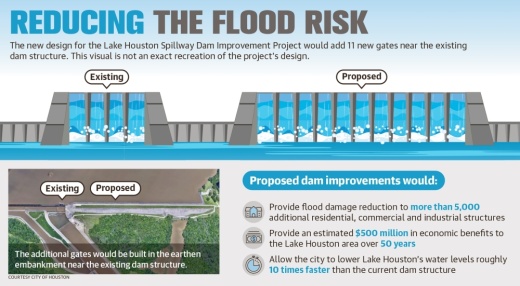“I waited there for three days not knowing whether she was alive or dead or whether the house was destroyed,” said Rehak, a local flood expert who runs ReduceFlooding.com. “I was going crazy.”
Rehak said his home, which is positioned just north of the San Jacinto River near Lake Houston, was the first property positioned between his home and the river that did not flood during Harvey. Most of his neighbors’ properties, however, were heavily damaged.
Since Harvey, the city of Houston, Harris County, and state and federal officials have worked to address the shortcomings of the Lake Houston spillway dam that have been attributed, in part, to flooding around the lake during the hurricane. These efforts include a roughly $200 million design for improvements to the dam released in December that officials believe will provide a cost-effective solution to the limitations of the current structure.
The dam, which was built in 1953, consists of a spillway structure with four small gates that are made to release water at a rate of 10,000 cubic feet per second, Houston officials said.
According to the Harris County Flood Control District, the dam was overwhelmed with water discharged at a rate of 425,000 cubic feet per second during Harvey, which Rehak said contributed to the rapid rising of the San Jacinto River and flooding near his home.
Taylor Landin, chief policy officer for Partnership Lake Houston, stressed the importance of making improvements to the dam structure.
“Necessary flood gate improvements [to the Lake Houston dam] would prevent a recurrence of the devastating residential flooding that forced thousands out of their homes in the aftermath of Harvey,” Landin said.
While the Federal Emergency Management Agency approved a roughly $47.1 million grant to add gates to the existing dam structure in August 2019, Houston officials are asking the state for an additional $150 million to fund proposed improvements.
Design changes
Stephen Costello, chief recovery officer for the city of Houston, noted several difficulties the city has faced with the project, including problems with early designs and securing the additional funding needed to construct a project that will have a meaningful effect on flooding.
In December, Houston Mayor Pro Tem Dave Martin announced the city had scrapped a plan that would have added 500 feet of modern floodgates to the existing dam structure.
According to Costello, the design would have required a cofferdam—an enclosure built within a body of water—to create a dry environment that would allow the work to be carried out safely.
“The dam is 70 years old, and [the engineers were] worried that the structural stability of the dam would be compromised by the cofferdam,” he said.
After determining the design to be unfeasible, Houston officials announced in December a new design that would entail 11 additional gates being built into the existing embankment on the east side of the current dam structure.
Further, Costello said the new design received a higher benefit-to-cost ratio, which he said is determined by assessing the number of properties that would benefit from the project as well as social factors, including employees being able to drive to work through streets that are prone to flooding.
According to Costello, the additional gates would provide increased flood protection to more than 5,000 structures and provide more than $500 million in economic benefits over 50 years.
Costello said the new design would also allow the city to prepare for flooding more efficiently. The limitations of the dam currently require officials to begin releasing water roughly three days in advance of anticipated flooding. It is estimated the water could be released from the lake 10 times faster with the new design.
“If we open the [current] gates preemptively and flooding doesn’t occur, we’re subject to state fines for water rights issues, so this will avoid that problem,” Costello said.
Securing funding
While the FEMA grant approved in 2019 allocated roughly $47 million for the dam improvement project, Costello said the projected cost of the new design will fall between $200 million-$250 million.
In addition to the grant, Costello said the HCFCD allocated $20 million for the project in its $2.5 billion bond approved by voters in 2018. He noted an additional $7.5 million in federal funds has been earmarked for the project by the U.S. Congress.
Martin said the city is asking the state for an additional $150 million for the project, noting he is confident officials will be able to divert some of the state’s record $32.7 billion budget surplus toward the project during this year’s state legislative session.
“We’re talking to the right people,” Martin said. “It really depends on how the state is going to handle all these excess funds they have.”
On March 5, Rep. Charles Cunningham, R-Humble, submitted a budget request for an additional $150 million for the dam improvement project.
“My constituents remember all too well the devastation caused by Hurricane Harvey, and we must work to prevent such occurrences from ever happening again,” Cunningham said, noting the funding will be essential in achieving that goal.
If the city cannot secure additional funding from the state, Costello said the current 11-gate design could be scaled down to five gates, which would cost between $70 million-$150 million.
Costello said the estimated timeline for the project remains unclear due to the funding uncertainty, but the next step will be hiring an engineering firm to create a final design for the project, which could take up to 18 months once a firm is under contract. Once construction begins, he estimated the project would take about three years.
Additional efforts
Despite continued delays to the dam improvement project, Costello said the city has made progress to remove sediment buildup—also known as dredging—in Lake Houston and the west and east forks of the San Jacinto River resulting from Harvey.
Since Harvey, the city has spent roughly $226 million funded through state and federal grants to remove roughly 4 million cubic yards of sediment from the lake and the waterways feeding into it.
Cunningham noted he requested $50 million in the state’s budget for future dredging operations. Additionally, Costello said the city is working with the San Jacinto River Authority and the HCFCD on a pair of pilot projects aimed at capturing sediment as it flows into the lake to decrease the need for future dredging operations.
At the county level, Harris County commissioners in 2020 approved the creation of the Community Flood Resilience Task Force, a 17-member task force aimed at assisting the county in its long-term flood mitigation efforts.
Rehak, who was appointed to represent Harris County Precinct 3 on the task force, created ReduceFlooding.com in 2018 to publish his findings and aerial photographs of Lake Houston and the San Jacinto River.
While Rehak cited a historical unwillingness to fund meaningful flood mitigation efforts as a large contributing factor to major flooding events, he said he hopes the city can move forward with the dam project quickly.
“When they started the project, FEMA gave them three years,” Rehak said. “That was five years ago. Obviously, they got an extension, but at what point does FEMA say, ‘OK, this is taking too long. We’ve got to take the money back’?”







